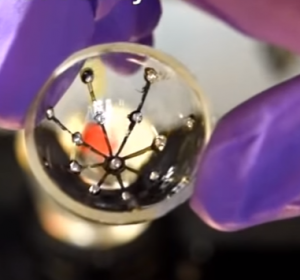For a long time, blindness was an irreversible condition, and that’s still true about many forms of it. If a person’s eyes or vision are damaged badly enough, there’s only so much medical professionals can do to restore function. If a person loses an eye, realistic-looking prosthetics can be created, but they’re for cosmetic purposes only. But what if prosthetic eyes could actually restore sight? That’s what a team of University of Minnesota researchers are hoping for.
In a paper entitled “3D Printed Polymer Photodetectors,” the researchers detail how they created what could eventually lead to an actual “bionic eye” by 3D printing photoreceptors on a hemispherical surface.
“Bionic eyes are usually thought of as science fiction, but now we are closer than ever using a multimaterial 3D printer,” said Michael McAlpine, a co-author of the study and University of Minnesota Benjamin Mayhugh Associate Professor of Mechanical Engineering.
McAlpine and his team were also responsible for a recent study that could lead to the regaining of function for people with spinal cord injuries. They have also created a bionic ear, an electronic fabric that could serve as bionic skin, and electronics that can be printed directly on human skin, as well as lifelike 3D printed organ models.
The researchers used a custom-built 3D printer to print onto a hemispherical glass dome. They used a silver particle base ink, which dried in place uniformly rather than running down the curved surface. They then used semiconducting polymer materials to print photodiodes, which convert light into electricity. The entire process took about an hour.
According to McAlpine, they were able to achieve 25 percent efficiency in converting the light into electricity using the 3D printed semiconductors.
“We have a long way to go to routinely print active electronics reliably, but our 3D-printed semiconductors are now starting to show that they could potentially rival the efficiency of semiconducting devices fabricated in microfabrication facilities,” McAlpine said. “Plus, we can easily print a semiconducting device on a curved surface, and they can’t.”
 The next step, he said, is to create a prototype with more light receptors that are even more efficient. The team also hopes to find a way to print on soft hemispherical material that can actually be implanted into a real eye. If they manage to do that, they may be able to restore or improve sight.
The next step, he said, is to create a prototype with more light receptors that are even more efficient. The team also hopes to find a way to print on soft hemispherical material that can actually be implanted into a real eye. If they manage to do that, they may be able to restore or improve sight.
“My mother is blind in one eye, and whenever I talk about my work, she says, ‘When are you going to print me a bionic eye?’” McAlpine said.
Maybe soon, in fact. 3D printing has been used to provide help to visually impaired people through things like tactile maps and books, but it hasn’t claimed to be able to restore sight. That could change if the University of Minnesota team is able to make further progress with its research – one day, it may even be possible for those who have lost one or both of their eyes to see again.
Authors of the paper include Sung Hyun Park, Ruitao Su, Jaewoo Jeong, Shuang-Zhuang Guo, Kaiyan Qiu, Daeha Joung, Fanben Meng, and Michael C. McAlpine.
Discuss this and other 3D printing topics at 3DPrintBoard.com or share your thoughts below.


33 Replies to “Breakthrough 3D Printed Bionic Eye Could Restore or Enhance Sight”
Comments are closed.